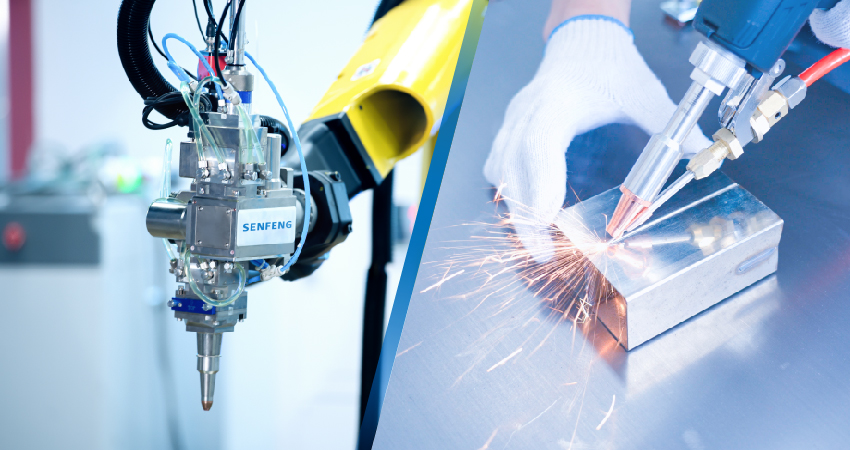
How Much Does a Fiber Laser Welding Machine Cost
Laser welding machines have become an essential tool for industries like automotive, aerospace, metal fabrication, and electronics manufacturing. Known for their precision, efficiency, and versatility, these machines offer significant advantages over traditional welding methods. However, one of the most common questions buyers ask is, “How much does a laser welder cost?” This article will provide an overview of different models, explain the factors that affect their price, compare laser welding with traditional methods, and offer guidance on how to select the right machine for your needs.
Different Models and Their Prices
The fiber laser welding machine price can vary significantly based on the model, power, features, and intended use. Here is a breakdown of common types and their price ranges:
Note: The prices of the equipment mentioned in the text are for reference only and may vary with market conditions.
1. Portable Handheld Laser Welding Machine
The portable handheld welding machine is compact in structure and takes up minimal space, making it ideal for small, precision workpieces. Its lightweight design allows customers to easily transport it, offering unmatched flexibility for various working environments. Additionally, this versatile machine not only performs welding but also handles cutting of small metal sheets, providing exceptional value for its cost. Its combination of portability and functionality makes it a top choice for those seeking an affordable and efficient solution.
Price Range: $9000 to $16000
2. Handheld Laser Welding Machine
Handheld welding machines are among the most popular and widely used welding equipment due to their compact design, fast welding speeds, and aesthetically pleasing welds. The price of these machines is influenced by their power, with common options including 1.5kW, 2kW, and 3kW models. If you’re considering adding external devices such as a rotary table, clamps, or a wire feeder, or additional features like remote control and automatic functionality, the cost will increase accordingly. These enhancements offer greater flexibility and automation for more complex welding applications.
Price Range: $9,000 to $25,000
3. Robotic and Handheld Laser Welding Machine
The robotic and handheld laser welding machine combines two functions in one, allowing for both handheld and robotic welding. This machine is ideal for customers who require batch processing, providing efficiency and versatility for high-volume production.
Price Range: $20,000 to $60,000
4. 3D Robot Laser Welding Machine
The 3D robot fiber laser welding machine offers a higher level of automation, making it the perfect tool for large-scale production of bigger workpieces. With power options ranging from 2000W to 20000W, this machine stands out for its wider adjustable spot size, allowing for welding of thicker materials with more aesthetically pleasing and stronger weld seams. Compared to traditional welding machines, its versatility makes it ideal for various applications. You can also customize additional equipment such as tooling, positioners, or robotic arms, although this will increase the overall cost.
Price Range: $16000 to $80,000
Advantages of Laser Welding over Traditional Welding
Laser welding has several advantages compared to traditional welding methods such as TIG, MIG, or arc welding. Here are some key benefits:
Precision and Accuracy
Laser welders use a concentrated beam of light to heat and melt the material, allowing for highly precise welds, even in complex shapes or small areas. This results in cleaner, stronger, and more aesthetically pleasing welds compared to traditional methods.
Speed and Efficiency
Laser welding system can complete tasks in a fraction of the time that traditional welding methods require. This efficiency translates into higher productivity, which is especially valuable in mass production settings.
Lower Heat-Affected Zones
Laser welders generate less heat during the welding process, minimizing the risk of warping or damaging the material. This makes it ideal for thin or delicate materials where traditional welding could cause distortion.
Minimal Post-Welding Work
The precision of laser welds means there is often little to no need for post-welding finishing work like grinding or smoothing. This saves time and reduces labor costs.
Automation Capability
CNC laser welding machines can easily be integrated into automated production lines, making them a great option for large-scale manufacturers that require consistent, high-quality welds.
Factors That Affect the Price of a Laser Welding Machine
The cost of a laser welding machine is influenced by several key factors:
Power Output
The laser source serves as the heart of the welding machine, determining its power output and consequently affecting its price. Currently, handheld welding machines typically have power levels ranging from 1.5 to 3 kW, while robotic welding machines can reach up to 20 kW. This variation in power not only influences the cost but also dictates the machine’s capabilities for different welding applications.
Features and Automation
Machines with advanced features such as automated control systems, integrated cameras for monitoring, and multi-axis capabilities will naturally cost more. Similarly, fully automated machines with robotic arms are more expensive than manual or semi-automatic models.
Brand and Manufacturer
The brand or manufacturer of the machine can also play a role in pricing. Established brands with a reputation for quality and reliability may charge a premium for their products. However, lesser-known brands can offer competitive pricing, albeit sometimes with compromises in service or support.
Additional Components
Custom external equipment, such as robotic arms, tooling fixtures, and rotary tables, will increase the cost of the equipment.
How to Choose the Right Laser Welding Machine
Selecting the right laser welding machine depends on your specific needs, budget, and long-term goals. Here are some tips to help guide your decision:
Evaluate Your Application
Consider what materials you will be working with and the thickness of those materials. For example, if you need to weld thin, delicate materials, a lower-powered machine may be sufficient. However, if you’re working with thicker metals, you may need a high-powered machine to ensure strong welds.
Consider the Work Environment
If you’re working in a small shop or need mobility, a handheld or portable model may be the best fit. For large-scale production, an automated machine with high throughput is a better investment.
Budget for the Long Term
While laser welding machines may have higher upfront costs than traditional welders, they often save money in the long run by increasing productivity, reducing material waste, and minimizing labor costs. Consider the long-term savings and benefits when evaluating your budget.
Look for After-Sales Support
Purchasing a laser welding machine is a significant investment, so it’s important to consider the level of support offered by the manufacturer. Ensure that the supplier provides adequate training, spare parts availability, and responsive customer service.
Test Before You Buy
If possible, test out different machines before making a final decision. This allows you to see firsthand how the machine performs with your specific materials and applications.
Conclusion
The cost of a laser welding machine varies depending on the model, features, and power output, with prices ranging from $8,000 to $200,000 or more. Despite the higher upfront cost, laser welding offers significant advantages over traditional methods, including greater precision, speed, and efficiency. When selecting a machine, consider factors such as your specific application, budget, and the long-term benefits of automation and higher productivity. Investing in the right laser welding machine can transform your operations and ensure a more efficient, cost-effective production process.

